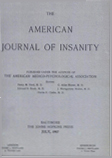PARALLEL PSYCHOLOGICAL, PSYCHIATRIC AND PHYSIOLOGICAL FINDINGS IN SCHIZOPHRENIC PATIENTS UNDER INSULIN SHOCK TREATMENT
Abstract
This paper attempts to illustrate a method of quantitatively assessing certain psychological, psychiatric and physiological changes occurring in a group of schizophrenic patients, before, during and after insulin shock therapy. These changes have been recorded in such a way as to permit their graphic presentation, except the electroencephalographic observations which in this series happen not to lend themselves to this type of presentation. Subsequent electroencephalographic observations suggest that it will bet possible to include their graphic presentation in a later report. The paper represents an effort to correlate simultaneous observations on a small group of schizophrenic patients, and suggests a fair correlation between the clinical psychiatric rating, psychometric rating and a lesser correlation between these two observations and the basal metabolic rate.
Five catatonics in this small group, showing marked psychomotor inertia, suggest that such patients show an abnormal fast frequency in the electroencephalogram.
Further work is now in progress to include sugar and insulin tolerance observations along with the basal metabolic rate, psychometric, psychiatric and electroencephalographic observations in a larger series than that presented in this paper.
Access content
To read the fulltext, please use one of the options below to sign in or purchase access.- Personal login
- Institutional Login
- Sign in via OpenAthens
- Register for access
-
Please login/register if you wish to pair your device and check access availability.
Not a subscriber?
PsychiatryOnline subscription options offer access to the DSM-5 library, books, journals, CME, and patient resources. This all-in-one virtual library provides psychiatrists and mental health professionals with key resources for diagnosis, treatment, research, and professional development.
Need more help? PsychiatryOnline Customer Service may be reached by emailing [email protected] or by calling 800-368-5777 (in the U.S.) or 703-907-7322 (outside the U.S.).



